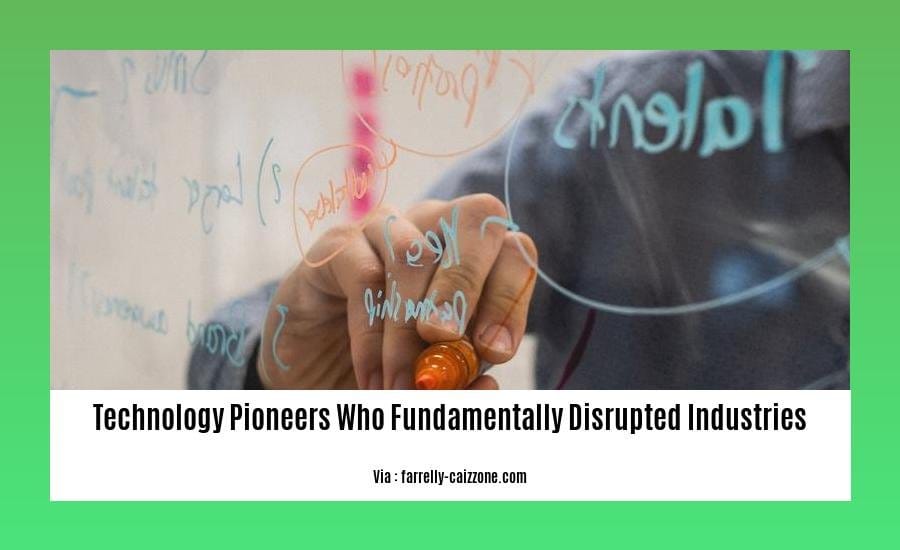**Technology Pioneers Who Fundamentally Disrupted Industries**

Key Takeaways:
- Generative AI: Artificial intelligence capable of creating original content like text and images.
- Edge Computing: Computing power distributed to devices at the network edge to improve response times.
- Virtual, Augmented, and Mixed Reality (VR/AR/MR): Technologies that create immersive virtual environments or overlay digital information onto the real world.
- Blockchain: Decentralized ledger system used to securely and transparently record transactions.
- Internet of Things (IoT): Interconnected devices that gather and exchange data, enabling remote monitoring and control.
Technology Pioneers Who Fundamentally Disrupted Industries
Today’s tech landscape is a testament to the visionary minds who dared to challenge conventions and reshape industries. These technology pioneers who fundamentally disrupted industries pushed the boundaries of innovation, transforming our lives and the way we interact with the world around us.
Generative AI: Unlocking the Power of Creation
Generative AI tools like ChatGPT and DALL-E 2 empower users to create original text, images, and even code. This transformative technology opens up endless possibilities for content creators, researchers, and businesses, revolutionizing industries such as marketing, entertainment, and software development.
Edge Computing: Bringing Power to the Edge
Edge computing decentralizes processing power, allowing devices to perform real-time data analysis and decision-making at the network’s edge. This reduces latency and improves efficiency, enabling applications such as self-driving cars, smart cities, and remote healthcare.
VR/AR/MR: Immersive Experiences Like Never Before
Virtual, augmented, and mixed reality technologies create immersive experiences that simulate virtual environments or overlay digital information onto the real world. These game-changing technologies have applications in entertainment, training, education, and e-commerce, offering users unprecedented levels of engagement and interactivity.
Blockchain: Secure and Transparent Transactions
Blockchain technology provides a decentralized and immutable ledger system for recording transactions. This groundbreaking innovation eliminates intermediaries, enhances security, and increases transparency, transforming industries ranging from finance to supply chain management.
IoT: Interconnecting the World
The Internet of Things (IoT) connects billions of devices, enabling them to collect and exchange data remotely. This vast network of interconnected devices empowers businesses to optimize operations, monitor assets, and deliver personalized services, revolutionizing industries such as manufacturing, transportation, and healthcare.
These technology pioneers who fundamentally disrupted industries are true visionaries who have left an indelible mark on the world. Their innovations have shaped the way we live, work, and interact with technology, inspiring future generations of innovators and setting the stage for even greater disruptions in the years to come.
Dive into the world of innovators whose inventions revolutionized technology, where brilliant minds ignited technological advancements. Get inspired by the pioneering creators of transformative tech who shaped our modern world. Explore the stories of revolutionary innovators who sparked tech revolutions, whose ideas transformed our lives forever.
The Art of Foresight: Anticipating Industry Shifts
Navigating the Evolving Tech Landscape
In the fast-paced world of technology, the ability to anticipate industry shifts is crucial for success. The Art of Foresight empowers us to predict potential opportunities and challenges, enabling us to adapt and thrive in an ever-changing environment.
Key Takeaways:
- Adopt a horizon-centric approach, considering both near-term and long-term impacts of emerging technologies.
- Explore and anticipate future developments, identifying potential game-changers and disruptive forces.
- Embrace technology foresight as a tool to navigate complex and uncertain business landscapes.
- Organizations increasingly demand foresight capabilities to stay competitive and make informed decisions.
Steps to Develop Foresight:
- Monitor industry trends: Stay informed about emerging technologies, market shifts, and customer behaviors.
- Build a foresight team: Gather experts from various fields to bring diverse perspectives and knowledge.
- Use foresight tools: Leverage software and frameworks to analyze data, identify weak signals, and develop roadmaps.
- Create foresight scenarios: Explore multiple potential futures based on different assumptions and variables.
- Continuously refine: Regularly assess and update foresight plans as new information emerges.
Benefits of Foresight:
- Enhanced decision-making: Informed by future insights, leaders can make strategic choices that align with emerging trends.
- Innovation acceleration: Foresight helps identify potential breakthroughs and accelerate the development of transformative technologies.
- Risk mitigation: By anticipating potential challenges, organizations can prepare mitigation strategies and minimize risks.
- Competitive advantage: Those who embrace foresight gain a significant edge over competitors by staying ahead of industry shifts.
Remember, the Art of Foresight is not about perfect predictions but about leveraging knowledge and imagination to anticipate the future and shape it to our advantage.
Citation:
- World Economic Forum, “Why strategic foresight is essential for future preparedness,” March 27, 2024
Overcoming Barriers: Challenges and Resilience
Key Takeaways:
- Prioritize services based on criticality.
- Establish a blame-free culture to foster resilience.
- Regularly conduct simulation exercises to test resilience.
- Implement continuous monitoring systems to detect and mitigate issues.
- Assess risks and allocate resources for optimal resilience.
Understanding the Resilience Spectrum
Resilience is not a one-size-fits-all concept. It exists on a spectrum, ranging from individual system ownership to enterprise-wide coordination. The appropriate level of resilience depends on the specific context and requirements.
Risk-Based Resilience: A Strategic Approach
Overcoming barriers and building resilience require a risk-based approach. By assessing risks and allocating resources accordingly, organizations can effectively mitigate potential threats and ensure business continuity.
Steps to Foster Resilience
- Prioritize services based on criticality to minimize disruptions.
- Promote a blame-free culture where mistakes are seen as learning opportunities.
- Conduct simulation exercises to identify and address vulnerabilities.
- Implement 24/7 monitoring systems to detect and respond to issues promptly.
- Allocate resources based on risk assessments to minimize the impact of potential disruptions.
Building a Resilient Technology Framework
By embracing these strategies, organizations can construct a robust and resilient technology framework that can withstand challenges and ensure uninterrupted operations.
Citation:
McKinsey & Company: A Technology Survival Guide for Resilience
Legacy and Impact: The Enduring Influence of Pioneers
In the realm of technology, visionary pioneers have left indelible marks, disrupting industries and shaping our digital landscape. Their legacies extend far beyond their creations, inspiring generations and fostering enduring advancements.
Key Pioneers and Their Lasting Impacts
- Steve Jobs: Revolutionized computing, music, and mobile technology with Apple’s Macintosh, iPod, and iPhone.
- Bill Gates: Founded Microsoft, making personal computers accessible and transforming software development.
- Elon Musk: Trailblazed electric vehicles with Tesla, space exploration with SpaceX, and AI research with Neuralink.
- Jeff Bezos: Established Amazon as an e-commerce giant, revolutionizing retail and cloud computing.
Enduring Impacts of Pioneer Innovations
- User-centric Design: Pioneers like Jobs emphasized user experience, making technology intuitive and accessible.
- Pace of Innovation: Their relentless drive for innovation set a precedent for continuous advancements.
- Inspiration for New Leaders: Their entrepreneurial spirit and visionary thinking inspire aspiring tech leaders.
- Global Connectivity: Advancements in internet technology have fostered global communication and commerce.
- Transformation of Industries: From healthcare to entertainment, pioneering advancements have reshaped entire industries.
Key Takeaways:
- Pioneers leave lasting legacies that shape future technologies.
- Their innovations create foundational principles for user-centric design and relentless advancement.
- They inspire new generations of innovators and entrepreneurs.
- Their contributions transform industries and enhance our lives.
Citation:
- “The Many Contributions of Steve Jobs (1955-2011)” by Smithsonian Magazine (

FAQ
Q1: Who is considered to be one of the most influential technology pioneers?
A1: Steve Jobs, the co-founder of Apple, is widely recognized as one of the most influential technology pioneers for his revolutionary contributions to the computer, music, and mobile phone industries.
Q2: What was the significance of the first Macintosh computer?
A2: The Macintosh computer, introduced in 1984, popularized the graphical user interface (GUI), making computers more accessible and user-friendly for the general public.
Q3: Which technology had a profound impact on the music industry?
A3: The iPod, introduced in 2001, revolutionized the way people listen to music by providing a portable and user-friendly platform for managing and playing digital music files.
Q4: What is the key to fostering innovation and creativity within a company?
A4: To foster innovation and creativity, companies can promote a culture that values experimentation, encourages risk-taking, and provides resources to support the development of new ideas.
Q5: How can organizations prepare for the impact of disruptive technologies?
A5: Organizations can prepare for the impact of disruptive technologies by conducting horizon-centric analysis, exploring potential challenges and opportunities, and implementing strategies to enhance their resilience to technological advancements.












